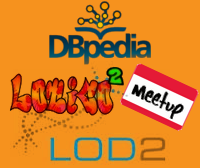
Session, FRI 10:30 - 12:00
Enterprise Linked Data Applications
Shape Expressions: An RDF validation and transformation language
RDF is a graph based data model which is widely used for semantic web and linked data applications. In this paper we describe a Shape Expression definition language which enables RDF validation through the declaration of constraints on the RDF model. Shape Expressions can be used to validate RDF data, communicate expected graph patterns for interfaces and generate user interface forms.
In this paper we describe the syntax and the formal semantics of Shape Expressions using inference rules. Shape Expressions can be seen as domain specific language to define Shapes of RDF graphs
based on regular expressions. Attached to Shape Expressions are semantic actions which provide an extension point for validation or for arbitrary code execution such as those in parser generators.
Using semantic actions, it is possible to augment the validation expressiveness of Shape Expressions and to transform RDF graphs in a easy way.
We have implemented several validation tools that check if an RDF graph matches against a Shape Expressions schema and infer the corresponding Shapes. We have also implemented two extensions, called
GenX and GenJ that leverage the predictability of the graph traversal and create ordered, closed content, XML/Json documents, providing a simple, declarative mapping from RDF data to XML and Json
documents.
Eric Prud'Hommeaux, Jose Emilio Labra Gayo and Harold Solbrig
University of Oviedo, Spain
Defining Expressive Access Policies for Linked Data using ODRL Ontology 2;0
Together with the latest efforts in publishing Linked (Open) Data, more and more interest has been shown concerning legal issues of published data. Especially in (i) how to define more expressive access policies which go beyond common licenses, (ii) how to introduce pricing models for online datasets and (iii) realize (i) and (ii) but be both human and machine readable.
In this paper, we show based on numerous examples that the Open Digital Rights Language (ODRL) Ontology 2.0 is able to solve all previous mentioned issues, i.e. is suitable to express a large variety
of different access policies for Linked Data. By defining policies as ODRL RDF triples we aim for (i) higher flexibility and simplicity in usage, (ii) machine/human readability and (iii) more fine
grained policy expressions for Linked (Open) Data.
Simon Steyskal and Axel Polleres
Vienna University of Economics and Business, Austria
An Open Linked Data Strategy for Tourism
The following high-level challenges from Salzburgerland Tourism (SLT is a Public Administration responsible for supporting tourism in the region of Salzburg) have shaped the Open Linked Data Strategy implemented by Insideout10 (an Italian company focused on Open Data and Semantic Web Publishing) using the Redlink platform (Redlink GmbH is company offering linked data publishing services and content analysis as-a-service in the cloud):
1. Cross-platform publishing: As more travellers begin massively using mobile devices the entire service offering shall be re-engineered targeting a comprehensive mobile user experience,
2. 3rd Party Content Syndication: With the increasing growth of location based social mobile apps (SoLoMo = Social + Local + Mobile) a large amount of information is nowadays directly delivered to travellers by 3rd party applications such as FourSquare, Facebook or Google.
3. Semantic Search Optimisation: As commercial search engines (Google, Bing, Yahoo!, Yandex and more) are starting to use semantic search more and more users are taking advantage of conversational search and voice-enabled application like Siri and Google Now.
4. Linked Data Ecosystem: Engaging with the local communities is key to nurture and maintain the virtuous circle of information between tourist operators, citizens, local businesses and tourists.
About
- At InsideOut10, we believe that the open exchange of ideas have a positive global impact. Every day we are inspired by stories of people using technologies to help make the world a better place in unexpected ways.
- InsideOut10 is delivering an innovative product called WordLift. WordLift brings the power of Artificial Intelligence to Web Publishers around the World turning editorial contents into actionable knowledge. WordLift integrates with WordPress a well-known open source CMS.
- InsideOut10 is currently main shareholder of Insideout Today L.L.C. an Egyptian startup powering the Internet revolution in Middle East and Africa and co-founder of REDLINK GmbH a commercial spin-off based in Austria and focused on Semantic Technologies, Linked Data and Free Open Source Software.
Andrea Volpini
Andrea Volpini is co-founder of InSideOut10 an innovative Internet startup and director of Insideout Today formerly Interact Egypt (an egyptian award winning creative digital agency focusing on the African continent) with eighteen years of world-class experience on Content Management, Digital Media and SoLoMo (Social + Local + Mobile). In 2013 Andrea Volpini and David Riccitelli (co-founders of InSideOut10) kick-started RedLink GmbH a commercial spin-off focusing on Semantic Content Enrichment and Search and headquartered in Salzburg, Austria.
David Riccitelli
David Riccitelli started working with the Internet when still in high school. He founded his first company in 1996 when he was 18 years old, he created an ISP from the ground up and later sold his
company and joined a group of professionals providing ECM and Media solutions to large corporations, TLCs and public institutions. In the last years David is deeply involved in the areas of the
Semantic Web, Social Media Integration and OVP. He’s contributing to Open Source software and participating in European research projects.





